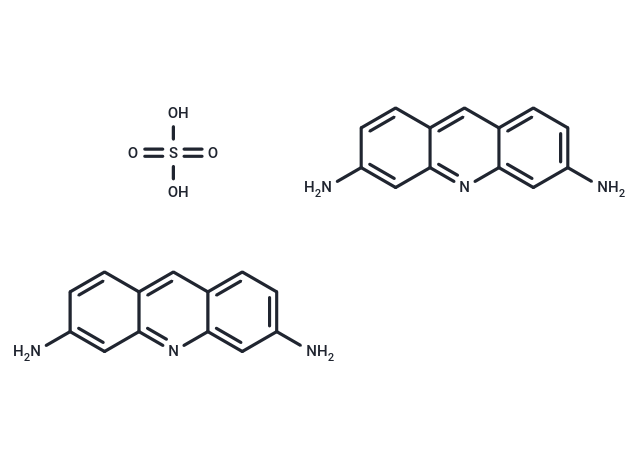Shopping Cart
Remove All Your shopping cart is currently empty
Your shopping cart is currently empty
Proflavine Hemisulfate (3,6-Diaminoacridine hemisulfate) is the hemisulfate salt form of proflavine, an acridine-derived fluorescent contrast and disinfectant agent that can potentially be used for cellular imaging and antiseptic purposes.

| Pack Size | Price | USA Warehouse | Global Warehouse | Quantity |
|---|---|---|---|---|
| 50 mg | $33 | In Stock | In Stock | |
| 100 mg | $47 | In Stock | In Stock | |
| 200 mg | $60 | In Stock | In Stock | |
| 500 mg | $95 | In Stock | In Stock |
| Description | Proflavine Hemisulfate (3,6-Diaminoacridine hemisulfate) is the hemisulfate salt form of proflavine, an acridine-derived fluorescent contrast and disinfectant agent that can potentially be used for cellular imaging and antiseptic purposes. |
| In vitro | Instructions I. DNA embedding 1. Preparation of Proflavine Hemisulfate solution: Dissolve Proflavine Hemisulfate in distilled water or buffer (such as PBS) to the required concentration (usually 1-10 µM, the specific concentration can be adjusted according to experimental requirements). Note: Make sure the solution is completely dissolved and mixed evenly. 2. DNA binding experiment: 1) Mix Proflavine Hemisulfate solution with DNA sample and conduct the experiment according to the required concentration. The binding of Proflavine and DNA will lead to enhanced fluorescence. Usually, the excitation wavelength is 450 nm and the emission wavelength is 510 nm. 2) The reaction time is 5-15 minutes as needed. 2. Fluorescence detection: 1) Measure the fluorescence intensity using a fluorometer or microplate reader. The excitation wavelength is 450 nm and the emission wavelength is 510 nm. 2) The fluorescence intensity is proportional to the amount of DNA and the embedding efficiency. 3. Applications: 1) DNA quantification and detection. 2) Study on DNA-protein interaction. 30 DNA conformation study. II. Antibacterial activity 1. Bacterial culture: Inoculate bacteria in an appropriate culture medium (such as LB fertilizer or agar plate) and culture to the desired optical density (OD). 2. Antibacterial experiment: 1) Dilute Proflavine Hemisulfate to the desired concentration (usually 10 µM to 100 µM) and add it to the bacterial culture. 2) Incubate bacteria with Proflavine Hemisulfate for 1-2 hours. The specific time can be optimized according to the bacterial growth rate and antibacterial activity. 3. Evaluation of antibacterial activity: 1) Monitor bacterial growth by colony counting or optical density measurement. 2) Evaluate the antibacterial effect of Proflavine Hemisulfate by observing the inhibition of bacterial growth. |
| In vivo | Proflavine acts as a Rev inhibitor, capable of targeting and binding to the high-affinity Rev binding sites of HIV-1. |
| Synonyms | Proflavin hemisulfate, 3,6-Diaminoacridine hemisulfate |
| Molecular Weight | 258.29 |
| Formula | C13H12N3O2S0.5 |
| Cas No. | 1811-28-5 |
| Smiles | OS(O)(=O)=O.Nc1ccc2cc3ccc(N)cc3nc2c1.Nc1ccc2cc3ccc(N)cc3nc2c1 |
| Relative Density. | 1.346 g/cm3 |
| Color | Red |
| Appearance | solid |
| Storage | keep away from direct sunlight | Powder: -20°C for 3 years | In solvent: -80°C for 1 year | Shipping with blue ice/Shipping at ambient temperature. | ||||||||||||||||||||||||||||||
| Solubility Information | H2O: 20.83 mg/mL (80.65 mM), Sonication is recommended. | ||||||||||||||||||||||||||||||
Solution Preparation Table | |||||||||||||||||||||||||||||||
H2O
| |||||||||||||||||||||||||||||||
| Size | Quantity | Unit Price | Amount | Operation |
|---|

Copyright © 2015-2025 TargetMol Chemicals Inc. All Rights Reserved.